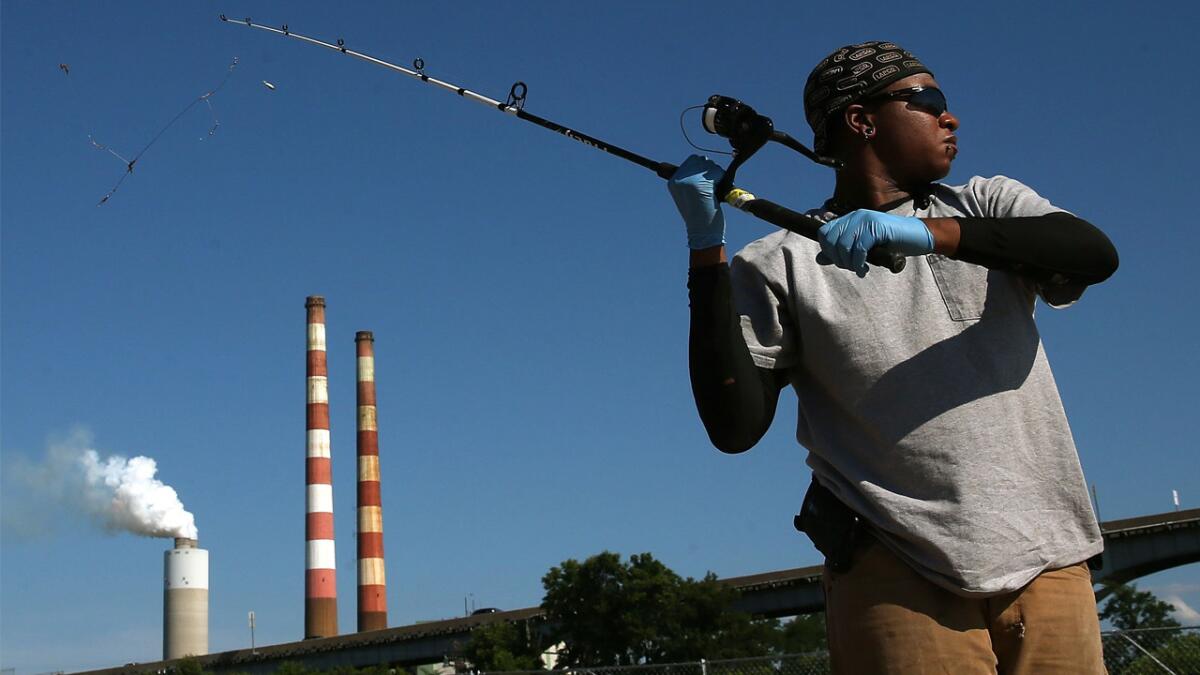Scientists blast EPA effort that would discredit health research in the name of ‘transparency’

- Share via
When the Environmental Protection Agency unveiled a proposal this week to give states more latitude in regulating pollution from power plants within their borders, it came with a sobering forecast of its likely impact on Americans’ health.
By 2030, adoption of the Affordable Clean Energy Rule could lead to 470 to 1,400 additional premature deaths each year because of an increase in tiny airborne particles. Children with asthma could wind up missing 21,000 extra days of school annually, and up to 48,000 more people could experience “exacerbated asthma” as air quality deteriorates.
Those estimates were made possible by decades-old studies that linked the rise and fall of microscopic airborne particulates — smog and other emissions from automobile tailpipes, factories and other industrial sources — to predictable patterns of premature death. It’s the kind of analysis that federal regulators will be barred from considering if the EPA adopts a controversial plan ostensibly designed to enhance the quality of research.
The Strengthening Transparency in Regulatory Science initiative would allow rulemakers to base their decisions only on studies whose raw data is available to the public. That way, anyone who doubts the findings can make their own attempt to validate, or discredit, them.
“The era of secret science at EPA is coming to an end,” former EPA Administrator Scott Pruitt said when he unveiled the initiative in April. “Americans deserve to assess the legitimacy of the science underpinning EPA decisions that may impact their lives.”
Who could possibly be against that?
Nearly 70 medical societies and public health groups, including the American Medical Assn., the American Academy of Pediatrics, the American Lung Assn. and the American Assn. for Cancer Research. In their view, it’s a backhanded attack on the key air pollution studies that forced companies to spend billions of dollars on cleaner factories and better equipment.
“I can’t come up with any explanation other than that they want to make this data available to vested interests by making it available to everyone,” said George Thurston, an environmental medicine researcher at New York University’s Langone School of Medicine who opposes the EPA initiative. “The problem is that people with an agenda can statistically manipulate the data and come up with really inappropriate conclusions. And if they have a profit motive, that’s likely to happen.”
Even the EPA’s own Science Advisory Board is skeptical. The board, which was not consulted on the transparency proposal, voted in May to review the initiative itself.
Before a four-month public comment period closed last week, more than 6,000 people and organizations weighed in on the proposal. It is now in the final stages of deliberation and could be adopted as early as this fall.
To Thurston, the tactic has a familiar ring.
Twenty years ago, he said, the EPA was examining research on the health effects of secondhand smoke and whether they warranted new restrictions on smokers. In a bid to gain access to the research and cast doubt on the findings, tobacco-industry allies pressed the agency to adopt “transparency” measures. The measure found its way into a House appropriations bill in 1998, but never made it into law.
“If you challenge the fundamentals, you challenge the finding,” said Janice Nolen, assistant vice president of policy for the American Lung Assn. “That’s why you’re seeing this proposal.”
The initiative comes at a vulnerable moment: In recent years, scientists have been grappling with the fact that in certain fields, too many landmark findings can’t be replicated by independent researchers. Editors of peer-reviewed science journals have responded with calls for broader sharing of data to ensure the integrity of new research.
The EPA says those voices “informed” its transparency initiative.
Scientists acknowledge that such openness is the ideal in research. But it’s not always practical.
Researchers are often bound by requirements to protect the privacy of their subjects. New methods in data management have made it possible to maintain privacy while sharing personal data, they said. But those often don’t help researchers whose subjects were enrolled decades ago.
Consider the 1993 “Six-City Study” and the 1995 American Cancer Society study, which both laid the groundwork for federal and state regulations aimed at reducing automobile and industrial emissions. They were based on the detailed tracking of air pollution exposures and health outcomes of 8,111 and 552,138 subjects, respectively.
The data on which the two studies rested were never wholly released to the public. The authors argued they could not do so without breaking a commitment to protect subjects’ privacy. That made it difficult for operators of coal-fired power plants, car manufacturers and other opponents of air pollution rules to challenge the studies’ findings.
While some kinds of technology may make it easier to shield the identities of research subjects, others may make it more difficult. Increasingly powerful computers can sift through genomes to find suspects, such as in the Golden State Killer case. It wouldn’t be hard to strip away study participants’ anonymity in cases where several publicly available databases are used to characterize their exposure to possible toxins, Thurston wrote in the journal Lancet Respiratory Medicine.
The EPA’s critics also say the proposal purports to fix a problem that scientists and regulators have generally addressed with other, less disruptive measures. For instance, if privacy concerns bar the public release of a research study’s data, independent third parties can be paid to review and reanalyze the study’s inputs and confirm or challenge its findings.
That’s what has happened to the two air pollution studies. In 2000, the EPA tapped an independent research group to conduct a reanalysis of the studies and their subsequent updates. The audit confirmed the original results.
Nolen said the transparency initiative appears to be part of a broader Trump administration assault on science.
“They’d like to be able to censor the science, to cast doubt on it by saying, ‘It’s not valid because it’s not transparent,’” she said.
Beyond discrediting past studies, the initiative would also undermine the quality of future environmental research, Thurston said.
If scientists can’t promise to protect subjects’ privacy, fewer of them would agree to participate. Smaller study populations mean less convincing findings. Less convincing findings don’t justify complex or costly environmental regulation to protect Americans’ health.
The scaring-off of research participants is already happening, Thurston said. The trend is most clear among immigrants and those in poverty — the kinds of people who were underrepresented in earlier research, yet tend to face more consistent exposure to environmental toxins.
“It’s very difficult to get those populations,” he said. “It’s getting harder and harder.”
Twitter: @LATMelissaHealy







